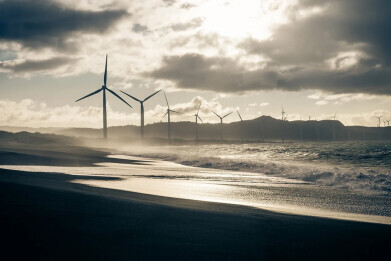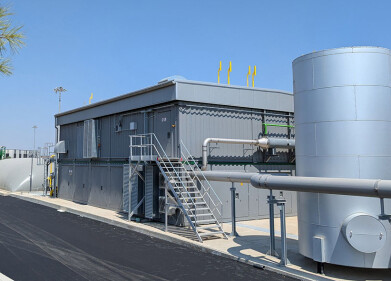Air clean up
Common Myths About Clean Energy Transition in the Philippines: Debunked!
Apr 19 2024
Monday 22 April is Earth Day, and in the Philippines the transition away from coal and towards renewable energy is not just an environmental imperative but a critical move for public health and economic prosperity.
Coal, a predominant source of energy in the country, is not only one of the largest contributors to global greenhouse gas emissions but also an important source of air pollution.
"Air pollution poses severe health risks, from respiratory ailments to heart diseases, affecting millions of Filipinos. As the Philippines endeavours to secure a sustainable future, reducing dependence on coal becomes crucial.
This Earth Day and beyond, it is vital that we debunk prevailing myths about clean energy transition, emphasising the tangible benefits of renewable energy for the people of the Philippines."
- Glynda Bathan-Baterina, Deputy Executive Director, Clean Air Asia
Myth 1: "Energy Transition is too expensive for the Philippines"
Reality: The perception that renewable energy is prohibitively expensive is outdated. Significant global investments in renewables have led to dramatic cost reductions. Specifically, the integration of renewable energy since the turn of the century has cut electricity sector fuel costs worldwide by a staggering $520 billion, demonstrating that clean energy is increasingly economically viable [1]. With solar contributing 1.7% of the Philippines' power generation in the first half of 2022, the country avoided around PHP 4.5 billion in fossil fuel costs [2]. While there may be initial costs involved in transitioning to renewables, the Philippines can then leverage its abundant solar, wind, and geothermal resources to promise substantial long-term savings and energy price stability.
The price of electricity from solar is around PHP4 per kilowatt hour compared to PHP9 per kWh from coal [3]. This month, Meralco paid PHP17 per kWh for coal power [4]. In the coming years, it is expected that costs of solar and other renewables will decline with technology improvements, greater economies of scale and reduced financing costs for wind and solar power plants [5].
It is important also to always consider the health impacts. Children are particularly vulnerable to the health impacts of air pollution from coal-fired plants because of their still developing brains and bodies. Infants born within 20km of more than one coal-fired power plant had significantly greater chances of a low birth weight and very preterm delivery. [6]
Myth 2: "Renewables can't provide stable energy in the Philippines due to weather dependence"
Reality: Advances in renewable energy technologies and grid management have greatly enhanced the reliability of renewables, even in the face of variable weather conditions. Energy storage solutions and diversified renewable sources, such as solar and wind, complemented by geothermal energy, which is less weather-dependent, ensure a stable and reliable energy supply [7]. This effectively counters the myth of renewables' unreliability due to weather dependency, making them a dependable energy source for the Philippines. Comprised of over 7,000 islands, distributed renewable energy systems are particularly suited to the Philippines as these systems do not require the transport of fuel to islands. These systems also reduce the need for extra-long transmission lines vulnerable to extreme weather events, and battery technology can provide a quick backup of power during disasters [8].
Myth 3: "Renewable Energy cannot meet the Philippines' growing energy demand"
Reality: Despite concerns, renewable energy is increasingly capable of meeting the Philippines' energy demand [9]. The country's current reliance on coal has not prevented energy shortages and brownouts, including the recent energy supply issues such as in Iloilo, demonstrating coal's inability to meet demand reliably. These issues underscore the limitations of traditional energy sources and highlight the urgency for transitioning to renewables. With its rich resources in solar, wind, and geothermal energy (in fact, the Philippines has the third largest geothermal capacity in the world) [10], the Philippines is well-equipped to address these challenges, ensuring a stable, sustainable energy future beyond the constraints of coal dependency. By diversifying its energy mix and investing in renewable energy infrastructure, the country can mitigate the risks associated with over-reliance on fossil fuels while ensuring a stable and secure energy future.
Myth 4: "Transitioning to clean energy will hurt the Philippine economy"
Reality: The economic benefits of transitioning to clean energy are manifold. The downward trend in renewable energy costs makes it a competitive alternative to fossil fuels, promising job creation in the renewable sector and aligning with global efforts to reduce carbon emissions [11]. Moreover, the health benefits of reduced air pollution, such as fewer days lost to illness and lower healthcare costs, further underscore the economic gains from investing in clean energy sources.
This transition supports the Philippines' economic growth and sustainable development. Every dollar invested in the clean energy transition provides 3-8 times the return [12]. Renewable energy adoption can also create many jobs (the renewable energy sector has employed 12.7 million people around the world as of 2021) [13].
Coal-fired plants also pose a danger to children’s neurodevelopment. In a study of children aged 6-14 years old from communities located within 10 miles (16 kilometres) of two coal-burning power plants, forty-three (43%) percent of children had fly ash in their homes. The children with fly ash in their homes scored on average 2.63 points lower on the school competency scale than their peers without ash in their homes [6].
Myth 5: "An energy transition cannot be 'Just' for all Filipinos"
Reality: There's a prevailing belief that the shift from coal to renewable energy could disproportionately benefit urban and wealthier populations, leaving behind rural and poorer communities. However, a just transition strategy, carefully planned and implemented, ensures that the move to clean energy is inclusive and equitable. By involving community stakeholders in the planning process and investing in skills training and education, the transition can provide new economic opportunities in renewable energy sectors across the country. Additionally, decentralised renewable energy projects can bring reliable and affordable power to remote areas, improving access to energy for all Filipinos.
By equipping people with the necessary knowledge and skills, the transition to clean energy can create new economic opportunities and promote social mobility, particularly for those traditionally marginalised in the energy sector. A just energy transition is not only achievable but imperative for the Philippines. By embracing principles of inclusivity, equity, and community participation, the transition to clean energy can pave the way for a more sustainable, prosperous, and equitable future for all Filipinos.
Conclusion
Embracing renewable energy in the Philippines presents a path toward sustainable development, economic growth, and improved public health. By addressing and debunking myths about clean energy wherever they occur, we can encourage a deeper understanding and acceptance of the benefits of clean energy, advocating for informed policy decisions to break the country’s reliance on coal and improve the health of all Filipinos.
References
1. International Renewable Energy Agency (2023). ‘Renewables Competitiveness Accelerates, Despite Supply Chain Challenges’.
2. Cabico, G. (2022), Philippines saved P4.5B in fossil fuel costs through solar generation - report
3. Layug J., quoted by Crismundo K., (2023) PH needs to reverse declining RE share in energy mix
4. Meralco (2024), Breakdown of Generation Charge (April 2024)
5. United Nations (accessed 2024), The facts on climate and energy
6. Clean Air Asia (2023), Impacts of Coal-fired Power Plant Emissions on Children's Health(Infographic)
7. Russo, M.A., Carvalho, D., Martins, N., & Monteiro, A. (2021). ‘Forecasting the inevitable: A review on the impact of weather-dependent renewables on energy systems’.
8. Marlon Joseph Apanada and Emily Kaldjian (2021) ‘Why the Time Is Right for Renewable Energy in the Philippines’
9. International Energy Agency (2023). ‘Electricity Market Report 2023’.
10. Mercurio, R. (2023), Philippines aims to reclaim spot as 2nd biggest geothermal producer
11. Roser, M. (2020). ‘Why did renewables become so cheap so fast?’.
12. World Economic Forum (2020), How Corporate PPAs can help drive Europe's green recovery
13. ILO (2022) citing IRENA 2022 Renewable Energy and Jobs: Annual Review 2022 report, Renewable energy jobs hit 12.7 million globally
14. United Nations Conference on Trade and Development (2020). ‘The costs of achieving SDGs: Energy Transition’.
Events
Apr 08 2025 Targi Kielce, Poland
Apr 08 2025 Bahrain
Apr 10 2025 Beijing, China
Apr 10 2025 Beijing, China
Apr 15 2025 Moscow, Russia














